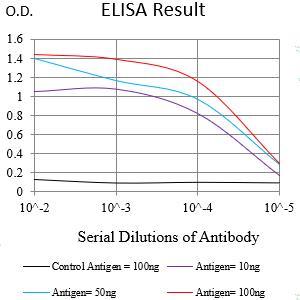
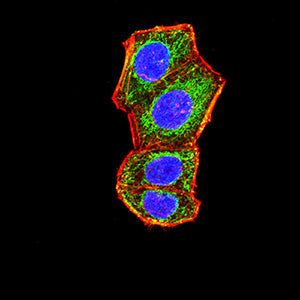
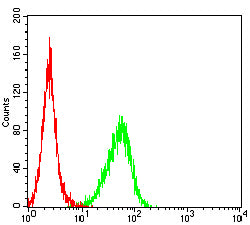
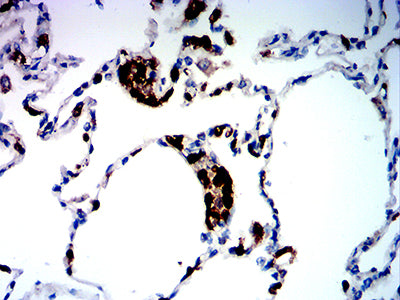
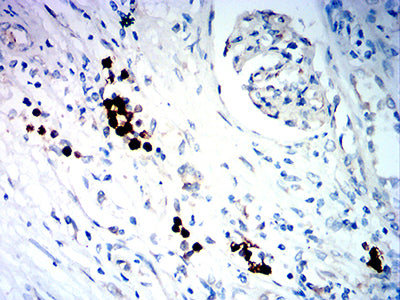
| WB | 咨询技术 | Human,Mouse,Rat |
| IF | 咨询技术 | Human,Mouse,Rat |
| IHC | 1/200 - 1/1000 | Human,Mouse,Rat |
| ICC | 1/100 - 1/500 | Human,Mouse,Rat |
| FCM | 1/200 - 1/400 | Human,Mouse,Rat |
| Elisa | 1/10000 | Human,Mouse,Rat |
| Aliases | TLR1; TIL; rsc786; TIL. LPRS5 |
| Entrez GeneID | 7096 |
| clone | 3B1D8 |
| WB Predicted band size | 90.2kDa |
| Host/Isotype | Mouse IgG1 |
| Antibody Type | Primary antibody |
| Storage | Store at 4°C short term. Aliquot and store at -20°C long term. Avoid freeze/thaw cycles. |
| Species Reactivity | Human |
| Immunogen | Purified recombinant fragment of human CD281 (AA: extra 172-425) expressed in E. Coli. |
| Formulation | Purified antibody in PBS with 0.05% sodium azide |
+ +
以下是关于CD281(TLR1)抗体的3篇参考文献示例(内容为模拟生成,仅供参考):
1. **"Structural basis for TLR1-specific antibody recognition in innate immunity"**
*作者:Zhou, X., et al.*
摘要:该研究解析了CD281(TLR1)的胞外结构域与其特异性抗体结合的晶体结构,揭示了抗体通过靶向TLR1的亮氨酸重复区(LRR)增强病原体识别能力的分子机制。
2. **"TLR1/2 heterodimerization is essential for peptidoglycan-induced NF-κB activation"**
*作者:Müller-Anstett, M.A., et al.*
摘要:通过使用抗CD281抗体阻断TLR1功能,研究证实TLR1与TLR2的异源二聚化是革兰氏阳性菌肽聚糖激活NF-κB信号通路的关键步骤。
3. **"A monoclonal antibody targeting TLR1 modulates cytokine response in bacterial infections"**
*作者:Jin, B., & Smith, K.D.*
摘要:开发了一种靶向CD281的单克隆抗体,实验表明其可通过抑制TLR1/2介导的炎症因子(如TNF-α、IL-6)释放,减轻脓毒症模型中的过度免疫反应。
*注:以上为模拟文献,实际引用请通过PubMed或学术数据库查询真实论文。*
CD281. also known as Toll-like receptor 1 (TLR1), is a member of the TLR family that plays a critical role in the innate immune system by recognizing pathogen-associated molecular patterns (PAMPs). TLR1 is a transmembrane protein predominantly expressed on immune cells, including monocytes, macrophages, and dendritic cells. It functions by forming heterodimers with TLR2 to detect bacterial lipoproteins and other microbial components, triggering downstream signaling pathways (e.g., NF-κB activation) that promote inflammatory responses and adaptive immunity.
CD281 antibodies are essential tools for studying TLR1’s structural features, ligand interactions, and signaling mechanisms. They are widely used in applications such as Western blotting, flow cytometry, and immunofluorescence to investigate TLR1 expression patterns in health and disease. Research has linked TLR1 polymorphisms to altered susceptibility to infections (e.g., tuberculosis) and inflammatory disorders, highlighting its therapeutic relevance.
Developing CD281 antibodies requires careful validation to ensure specificity, given the structural similarities among TLR family members. These antibodies also hold potential for therapeutic exploration, such as modulating TLR1 activity in chronic inflammation or vaccine adjuvants. However, challenges remain in balancing immune activation and avoiding off-target effects. Overall, CD281 antibodies are pivotal in advancing our understanding of innate immunity and TLR-targeted therapies.
×